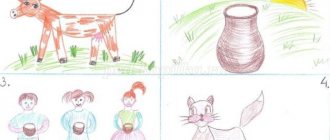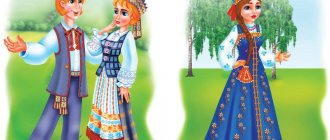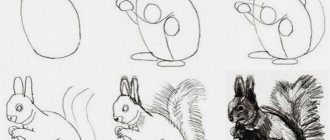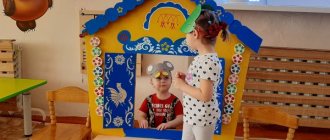MAGAZINE Preschooler.RF
Lesson on the environment on the topic “How animals prepare for winter”Goals:
- Expand children's understanding of the diversity of natural phenomena.
- Help establish simple connections between them. Reinforce ideas about seasonal changes in nature.
- Expand ideas about life in natural conditions of animals, what they eat, how they adapt to life in winter conditions.
- Foster a love for nature and respect for it. To instill in children a positive attitude towards work and a desire to work.
- Develop fine motor skills of the fingers; encourage creativity and independence.
- Develop children's speech.
Visual material: bird, letter, silhouettes of animals (squirrel, hare, bear), model of a forest.
Handouts: glue, brushes, cardboard silhouettes of animals, cereals (semolina, buckwheat, millet), winter clothes (hats, scarves, mittens)
- Organizing time
- Progress of the lesson.
- Hello guys, hello our dear guests. Today we will show our guests how we can practice (a knock is heard).
Educator: Guys, who is this knocking on our door, asking to join our group? (I bring in the bird with the letter). Yes, this is an owl that flew to us. She brought us a letter
Who did the letter come from? You want to know, right? Then you have to try to guess all the riddles.
Puzzles.
- The animal is shaggy, clubfooted, He sucks his paw in the den. (bear)
- Who deftly jumps through the trees? And flies up into the oak trees, Who hides nuts in a hollow, Dries mushrooms for the winter. (squirrel)
- Who walks through the forest angry and hungry in the cold winter? (wolf)
- Cross-eyed, small, wearing a white fur coat and felt boots. (hare)
Educator: Well done guys! All the riddles were solved.
Educator: A letter from our friends - forest animals. They write that they lived well in the forest clearing. They lived without grieving, they were friends with each other, squirrels and hares, bear cubs and wolf cubs. They played together happily, but forgot about winter. It became cold outside: it was snowing, cold rain was pouring, the wind was howling, and the branches of the trees were being torn off. The animals forgot to sew warm fur coats and ask you for help.
- You are good guys, will you help the animals?
Let's go with you to the forest and try to help our friends, but let's take moms and dads with us (2-3 parents are called) But for this you need to dress your parents warmer so that they don't freeze (children dress their parents for a while)
Well done! Now you can go!
Fizminutka
We walked, walked, walked, found snowdrifts on the left, stood up, stood there, and walked again.
We walked, walked, walked, found a bump on the right, bent down, picked it up, and walked again.
“Now close your eyes and repeat after me:
1, 2, 3 turn around yourself and find yourself in a fairytale forest.
- Guys, how should you behave in the forest?
Children: Don’t make noise, don’t throw garbage, don’t break trees.
Educator: That's right, guys! Don't make noise, don't shout, but help each other.
Educator: But in front of you is a fairy-tale forest. Look carefully, what animals do you see?
Children: hare, bear, squirrel.
Educator: Where can we get warm fur coats?
Children: Buy at the store, sew.
Educator: But there is no store in the forest. And there is a forestry studio. I suggest you become tailors and insulate fur coats for animals from various grains, and your parents will help you! What grains do you see? (Buckwheat, rice, millet). (There are silhouettes of animals on the table). (Children spread PVA glue on the cardboard silhouettes of animals and sprinkle with cereal of the corresponding color).
- What will you use to make a fur coat for a bear? (from buckwheat)
— What color is the bunny’s fur coat? (white)
-What will you make it from? (from semolina)
— What color is the squirrel’s fur coat?
We have prepared our fur coats. But now the animals offer to play with them, collect cubes, and the parents will help us (the first group of children collects a squirrel, the second a bear, the third a bunny)
- What great guys you are! What wonderful fur coats we made and played with the animals.
While the animals are trying on fur coats, you and I will play the game . ”
- The hare is white in winter, and in summer ...... (gray)
- The hare has a short tail, and ears...... (long)
The hedgehog is small, and the bear...... (big)
- The hare is fluffy, and the hedgehog...... (prickly)
- The squirrel has a long tail, and the hare has ...... (short)
- Now put the figures in the forest clearing (model of the forest).
— Tell poems about your forest friends. (Children recite poems about animals for whom fur coats were made).
You tried very hard and the wild animals are grateful to you for your help! It was a pleasure to communicate with you. Thank you and our guests!
| Next > |
How does a hedgehog prepare for winter?
For some of our wild animals, being well prepared for winter is a matter of survival.
Because hedgehogs are nocturnal, we sometimes don't notice them scurrying around our garden, helping us fight off slugs, snails and even insects that damage the plants we carefully cultivate.
As winter approaches, hedgehogs begin to prepare for hibernation. Hibernating animals slow their heartbeat and breathing rate, lower their body temperature and lower their metabolism to conserve energy, so having a good supply of fat and a stable sheltering environment is vital.
Hedgehogs typically hibernate from October to March and need to rely on their fat reserves to survive until spring. However, there could be many reasons why your hedgehog may not have gained enough weight. For example, bad weather can be a reason. Or young age, i.e. the animal did not live long enough to gain sufficient weight.
So, as hibernation season approaches, it can't hurt to give your hedgehogs a helping hand when it comes to finding food. You can leave food in the garden; meat food for cats and dogs (without fishy taste), seeds, nuts, and cottage cheese are suitable. You can also find special food for hedgehogs in stores. However, under no circumstances should you feed your hedgehog bread or milk, as they do not digest such food well.
If you are lucky enough to have a hedgehog in your garden, one important thing you can do is make him his own little house! The sooner you place such a house in your garden, the more likely it is that you will have a new neighbor. Place the house in a quiet place and cover it with dry branches, leaves and sticks. If you suspect a hedgehog is sleeping in your garden, be careful not to disturb it.
How does a hare prepare for winter?
Hares do not hibernate, but a number of behavioral and physiological adaptations help them survive the winter. They have thick fur and a low surface area to volume ratio, which retains body heat. Hares sometimes dig shelters in the snow and huddle together to keep each other warm.
The main preparation of hares for winter is their ability to change their coat twice a year for better camouflage. In the fall, their thin brown fur gradually turns into a thicker white fur, giving them the ability to camouflage themselves against both summer and winter backgrounds. In spring, the fur turns brown again in response to increasing daylight hours.
To protect themselves when they sense danger, young hares usually remain motionless to blend into the surrounding background, but the usual strategy of adults is to run away and confuse the predator by rushing in different directions. Adult hares can cover a distance of up to three meters in one jump and reach speeds of up to 45 kilometers per hour.





